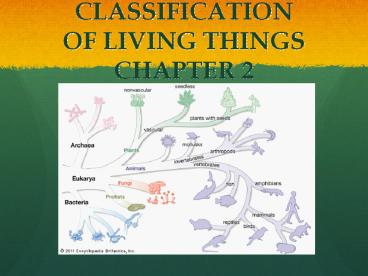CLASSIFICATION OF LIVING THINGS CHAPTER 2 - PowerPoint PPT Presentation
1 / 32
Title: CLASSIFICATION OF LIVING THINGS CHAPTER 2
1
CLASSIFICATIONOF LIVING THINGS CHAPTER 2
2
Bell Ringer 9/4/14
- Think about different ways you classify things.
List four groups of things that humans classify,
such as library books. What happens when you put
something in the wrong group? Can objects or
ideas belong in more than one group?
3
ObjectivesSPI 0807.5.1
- Explain why and how organisms are classified.
- List the eight levels of classification.
- Explain scientific names.
- Describe how dichotomous keys help in identifying
organisms.
4
Classification
- means organizing living things into groups based
on their similarities.
5
Why Classify?
- The classification of living things makes it
easier for biologist to answer important
questions such as - 1. How many known species there are?
- 2. What are the defining characteristics?
- 3. What are the relationships between
these species?
6
Early Classification systems
- Aristotle grouped animals according
- to the way they moved
7
Scientists classify
- living and extinct organisms to make them easier
to study.
8
Organisms are classified by
- shared characteristics and their relationships
between one another.
9
- The levels of classification go from very general
to very specific.
10
(No Transcript)
11
The 8 levels (pneumonic device)
- Domain..................................Did
- Kingdom...............................King
- Phylum..................................Philip
- Class.......................................Come
- Order......................................Over
- Family.....................................For
- Genus.....................................Grape
- Species....................................Soda
12
- The science of classifying organisms is called
taxonomy.
13
- Taxonomy was founded by Linnaeus in the 1700s.
- He classified things only by their shared
characteristics.
14
Modern Taxonomists Researchers
Look at evolutionary relationships between
animals
Recently found, buried Antarctic lake teems with
new life. Microbes living a lake deep under ice.
Biologists found these new living cells that have
been living in the lakes pitch-black water at a
frigid temperature of 0.49 degrees Celsius (31.1
degree Fahrenheit).
15
- A branching diagram can show relationships
between organisms. - Organisms that are more closely related are
closer together on the branching diagram.
16
Branching diagrams
Listen carefully. You will be practicing this in
groups next.
17
- When living things are classified, they get a
scientific name. - The scientific name is the same anywhere in the
world.
18
The 4 Rules to writing a Scientific Name
- 1. Scientific names are usually Latin or Greek.
- 2. The scientific name is always the genus and
species name together. - 3. The genus is always written first and
capitalized. The species is second and is always
lower case. - 4. The scientific name is always italicized or
underlined. - Example Felis domesticus
19
- Lion Tiger
- Kingdom Animalia Animalia
- Phylum Chordata Chordata
- Class Mammalia Mammalia
- Order Carnivora Carnivora
- Family Felidae Felidae
- Genus Panthera Panthera
- Species leo tigris
?With your elbow partner decide what is the same
about the lion and tiger? What is different?
20
Domains and Kingdoms
- Bacteria are prokaryotic, meaning they do NOT
have a nuclei. - All other living things are eukaryotic and have
nuclei.
21
Scientists use 3 Domains
- Archaea
- Bacteria
- Eukarya
Prokaryotes (no nucleus, single-celled organism)
Eukaryotes (have nucleus)
22
Scientists use 6 Kingdoms
- 1. Archaebacteria
- 2. Eubacteria
- 3. Protista
- 4. Plantae
- 5. Fungi
- 6. Animalia
23
Domain ArchaeaKingdom Archaebacteria
- Live in extreme environments (very hot or cold).
They have been on earth for about 3 billion
years.
24
Domain BacteriaKingdom Eubacteria
- Most bacteria live in Kingdom Eubacteria. They
live in many place all over earth and even inside
other organisms.
E. Coli lives in the intestines of animals and
decompose undigested food.
25
Domain EukaryaKingdom Protista
- Consists of unicellular and simple multicellular
organisms. Protista includes organisms that are
not plants, animals, or fungi.
Paramecium
Zooflagellates
26
Domain EukaryaKingdom Plantae
- Plants are usually green and make food by
photosynthesis. They are complex, multicellular
organisms. - In this kingdom, live the oldest unitary
organisms in the world...
27
BRISTLECONE PINE
Known to surpass 5,000 years in age.
28
GIANTSEQUOIAThis tree is no longer considered
the longest living tree, but may someday because
they live forever. Only dying when an external
physical event kills the, e.g. fire or erosion.
Oldest sequoia tree today 3,300 years of age and
its the largest member of Plantae
29
Domain Eukarya Kingdom Fungi
- They absorb food from their surroundings. Fungi
are usually multicellular (except yeast).
30
Domain EukaryaKingdom Animalia
- Most move around and have nervous systems.
Animals are complex multicellular.
31
Talking Turtles!
- Scientists study talking turtles in Brazilian
Amazon. - "These distinctive sounds made by turtles give us
unique insights into their behavior, although we
don't know what the sounds mean," said Dr. Camila
Ferrara, Aquatic Turtle Specialist for the WCS
Brazil Program. "The social behaviors of these
reptiles are much more complex than previously
thought. - http//www.eurekalert.org/pub_releases/2014-08/wcs
-ss081414.php
Giant South American river turtle. The turtle is
the largest member of the side-necked turtle
family and grows up to nearly three feet in
length.
32
EXIT TICKET
- Which domain has prokaryotic organisms?
- Which domain has eukaryotic organisms?































